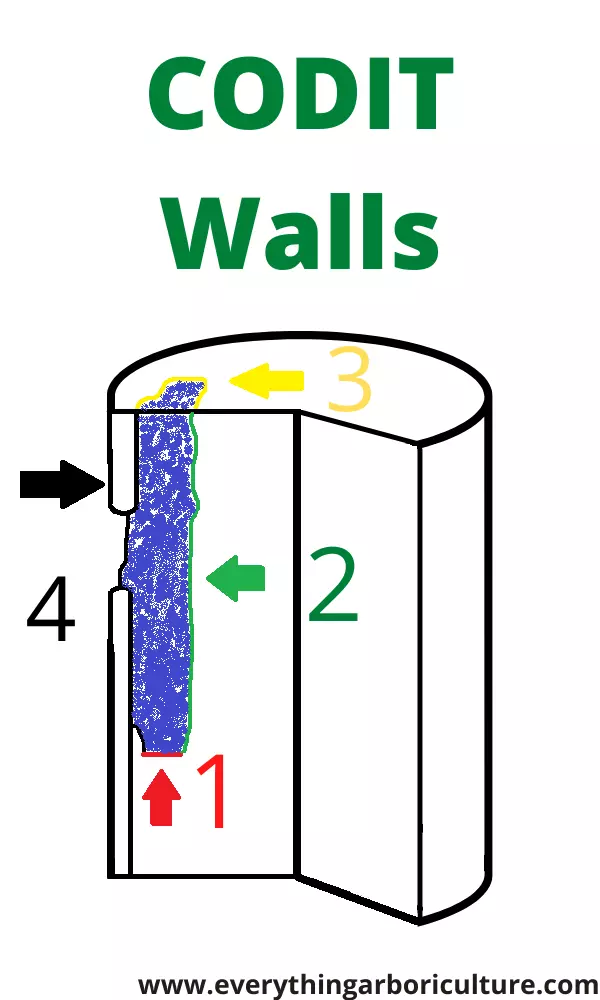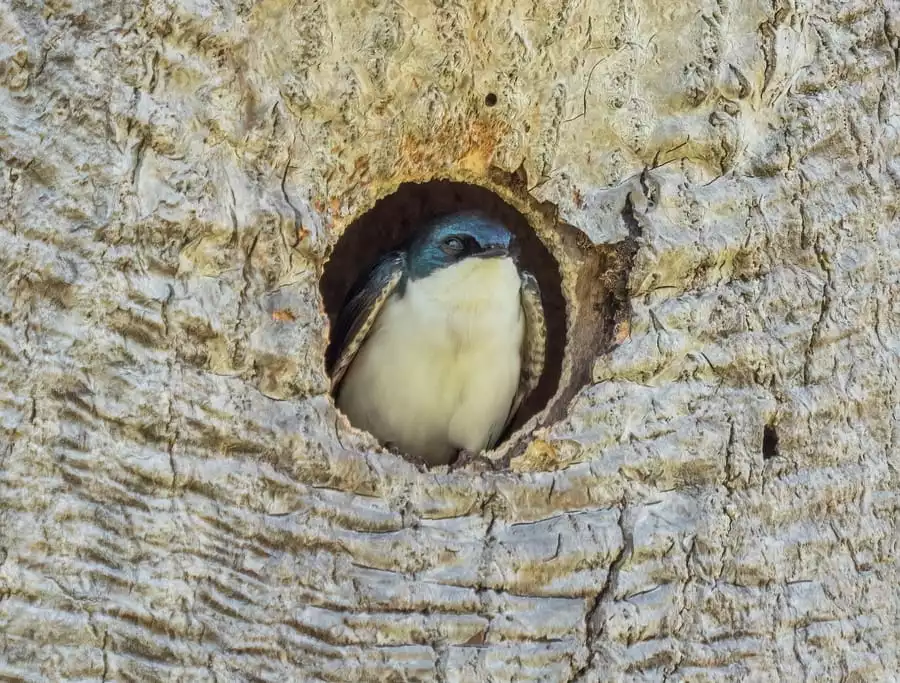
Trees aren’t like humans, they don’t heal damaged tissue. Instead, they use a process called CODIT to deal with wounds, but what exactly is CODIT?
CODIT is the process a tree uses to seal decayed or damaged wood. Rather than heal damaged tissue, the tree will create four barriers to stop any decay or infection from spreading to the rest of the tree. There are many benefits to this process, but it isn’t perfect. CODIT can produce weak points.
In this article, I will describe what CODIT is and how it works. I’ll then talk about some benefits and limitations of CODIT.
What is CODIT?
CODIT is the process trees undergo when injured. Rather than heal themselves, they isolate the affected area from the rest of the tree. The acronym CODIT stands for:
C – Compartmentalization
O – Of
D – Decay or Defect
I – In
T – Trees
Compartmentalization is a fancy way to talk about compartments. Think of a bag. You have all these different compartments, holding different things. Everything you put into these compartments is still in your bag. They’re just separated from each other. It’s the same with trees.
A tree will separate any wounds or infections from the rest of the tree. This damaged area will be part of the tree but in its own compartment. Hopefully, any infection or rot will stay in this compartment, keeping the rest of the tree healthy.
As you can see, healing in trees differs from healing in animals. In humans, the body repairs the infected or damaged tissues. Trees will seal off the infected or damaged tissues from the rest.
CODIT comprises two parts.
Part One – Three walls forming to stop the spread of decay.
Part Two – One wall that seals the wound.
How Does CODIT Work?
Now we have a general idea of CODIT. Let’s take a deeper look at how it works. In this section, I will cover the two parts of CODIT, including each of the four walls.
Remember, a tree is a 3D object, so there have to be several walls stopping decay travelling in all directions.

I’ll refer back to this diagram as I explain each wall. Note, the blue is the decay.
Part One of CODIT: Walls 1 – 3
Part One of CODIT begins immediately. The tree will construct three walls around the wound site, preventing infection or rot from traveling through the tree. I’ll cover each wall and its purpose.
The photosynthetic rate of a tree will determine how well the tree will compartmentalise. There are four main factors that influence photosynthesis.
Wall 1
Wall One will stop the spread of vertical decay. So, decay won’t be able to travel up and down the tree. However, this wall is the weakest, so in the right conditions, decay can still travel up or down the tree.
Red line in the diagram.
Wall 2
Wall Two will stop the spread of inward decay. So Wall Two will prevent decay from heading towards the centre of the tree. If the decay travels all the way to the pith (core of the tree), this wall no longer exists. It’s important this wall stops the decay, otherwise there’s no coming back.
As growth rings make up Wall Two, it’s a little stronger. The decay will have a tougher time moving between growth rings.
The green line in the diagram.
Wall 3
Wall Three will stop the spread of lateral decay. So, decay won’t be able to travel around the circumference of the tree. At first it was hard for me to understand this wall, that’s why I suggest thinking of trees as 3D objects.
Yellow line in the diagram.
Part Two of CODIT: Wall 4
So, the first three walls have prevented decay from traveling throughout the inside of the tree. It’s time for part 2, the sealing of the wound.
Wall 4
Wall Four (the strongest wall) will seal off the open wound from the rest of the tree. As the tree continues to grow, this wall will prevent decay from travelling out to new growth. Depending on the size of the wound and the health of the tree, the fourth wall may never completely cover the wound.
Black outer layer in the diagram.
Now we understand that trees will seal wounds, we can see why wound sealers are a bad idea. To find out more, check out this article on wound sealers.
Benefits and Limitations of CODIT
Now, CODIT isn’t perfect, there are a few limitations. I’ll go over some of these limitations below, but I’ll start with the benefits.

Benefits of CODIT
There are several benefits to CODIT, some more obvious than others.
Sealing Off Decay and Infection
As I’ve outlined throughout this article, CODIT can stop the spread of decay and infection in a tree. Provided the tree is healthy, the tree will create a small compartment to trap any nasties. I’ve talked about this point a lot, so I’ll keep it short.
Providing a Microenvironment For Organisms
The cavity created by the tree can be the home to many tiny organisms. Some of these include:
- Insects
- Fungi
- Bacteria
- Mould
- Roundworms
Some fungi or insects may rot and destroy trees, but these organisms can live and prosper inside the cavity without hurting the tree. So, it’s a mutually beneficial relationship.
Providing Habitat For Larger Creatures
Sometimes not all the CODIT walls work properly. What can happen is walls 1-3 form powerful barriers, but wall 4 doesn’t quite cover the wound. When this happens, a hollow forms. Hollows are the perfect home for a good deal of wildlife. Again, these include:
- Birds
- Bees
- Possums
- Squirrels
Hollows are a great option for some of these animals. The small opening can protect the animals from larger creatures trying to hunt them. So, always consider keeping hollows or dead trees around. Provided these trees are safe, you could give hundreds of creatures a place to call home.
Limitations of CODIT
Now for some of the limitations.
Weak Points
While Wall Four is strong and can stop the outward spread of decay, it can be the weak point later on. This wall will not be as strong as the fresh growth covering it, so this can lead to future cracks. As the tree gets older, this wall now inside the tree can be the starting point of internal cracks. If not monitored, these cracks can lead to limb failure.
Tree Starvation
CODIT requires energy, which means the tree needs to use more food. Using up all the resources can stress and starve the tree, weakening it. Provided the tree isn’t using CODIT too much, this shouldn’t be a problem. But repeated injuries are a cause for concern.
Injuries will require the tree to use its current resources and repeated injuries will take away future energy stores. When a tree creates a new compartment, that compartment can no longer be relied upon to store energy. Now, if the tree has injury after injury, the tree will have less and less storage. There will come a time when the tree won’t be able to store enough energy to maintain itself, which can lead to its death.
Defected Wood
CODIT will cause defects in a wood’s aesthetic. This isn’t too much of a problem for the average arborist or gardener. But, if you are felling a tree to sell the wood, this can be an issue. Defects and discolouration can vastly reduce the value of wood.
Conclusion
So, to summarize, we learned:
- Trees don’t heal damaged tissue, they section it off
- CODIT is the process a tree uses to section off wounds
- CODIT is a compromise of four walls that seal off the wound from the rest of the tree
Badly pruned trees can hinder CODIT, so these trees may need a little extra help. To learn how you can fix bad pruning jobs, check out this article here.
